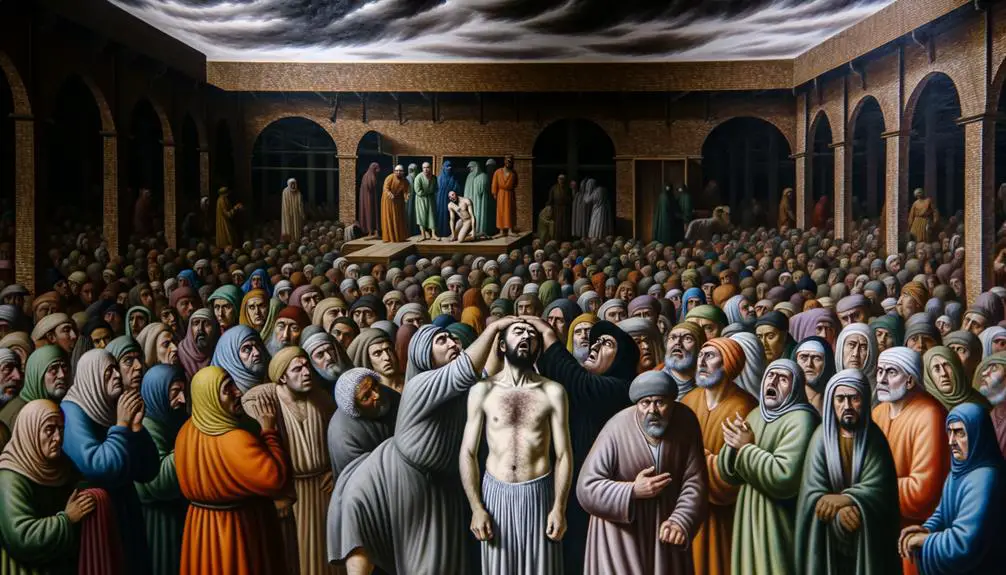Journey into the enigmatic tale of self-harm in the Bible, uncovering layers of mystery, meaning, and morality that resonate to this day.

Man Cutting Himself in the Bible
Mysteries and metaphors mingle in the biblical account of the man cutting himself, capturing your curiosity and compelling you to consider its deeper meanings.
In this story, you'll uncover layers of historical context, symbolism, and interpretations that have puzzled scholars and theologians alike.
From mental health perspectives to societal reactions and divine intervention, this narrative is ripe for exploration.
As you untangle the complex web of its modern relevance and the lessons learned, you'll find yourself questioning how ancient wisdom intersects with contemporary issues.
The answers might surprise you, inviting you to explore further into this intriguing topic.
Key Takeaways
- Self-cutting in the Bible symbolizes penance, mourning, or pleas for divine attention.
- It reflects cultural and religious landscapes, serving as prophetic actions or expressions of grief.
- Practices of self-cutting varied across regions, influenced by local beliefs and traditions.
- Understanding biblical instances of self-cutting offers insights into ancient religious and societal norms.
The Biblical Account

Several passages in the Bible describe individuals cutting themselves, a practice often linked to pagan rituals or expressions of intense grief. This action, while deeply personal, carries significant weight in the biblical narrative, often serving as a reflection of the cultural and religious landscape of the time. You'll find that these instances aren't merely historical footnotes but are imbued with prophetic actions and geographic significance that deepen our understanding of the text.
The act of cutting oneself in the Bible is rarely without context or purpose. Instead, it's often positioned as a stark contrast to the worship practices prescribed by Yahweh. This distinction is crucial because it not only highlights the divergence from monotheistic worship but also underscores the geographic significance of where these practices occurred. Regions with a strong presence of pagan worship, for example, are more likely to feature narratives involving self-harm as part of religious rites.
Moreover, the prophetic actions associated with self-cutting in the Bible serve as a tangible representation of the spiritual and emotional turmoil of the time. Prophets and other figures might've used these actions to convey a message from God, to demonstrate the depth of their despair, or to challenge the status quo of religious practice. Each instance of self-cutting is, therefore, not just an act of physical harm but a deeply symbolic gesture that resonates with the cultural and spiritual dynamics of the period.
Understanding these layers—prophetic actions and geographic significance—enhances your grasp of the biblical account, offering insights into the complex interplay between personal expression and the broader religious and cultural context.
Historical Context

Exploring the historical context of self-cutting in the Bible reveals how this practice reflects the societal norms and religious tensions of ancient times. This act, often seen through a modern lens as a cry for help or a personal struggle, held different connotations in the societies that the Bible's texts emerged from. Understanding this behavior requires delving into the ancient rituals and the regional influences that shaped these practices.
- Ancient rituals: Self-cutting was part of mourning or religious rituals in many ancient cultures. It was a tangible expression of grief or devotion, starkly contrasting with today's understanding.
- Regional influences: The practice wasn't uniform; it varied significantly across different regions, influenced by local beliefs and traditions.
- Mourning customs: In some societies, self-cutting served as a way to physically manifest one's sorrow and pain over the loss of a loved one, intertwining with rituals of mourning.
- Religious fervor: Among certain groups, it was a method to demonstrate religious zeal, a physical sacrifice to appease or communicate with deities.
- Societal norms: These actions must be viewed in the context of societal norms where physical expressions of spiritual beliefs or emotional states were more accepted and encouraged.
Through this lens, you can see how ancient practices of self-cutting were deeply embedded in the fabric of these societies, influenced by a complex interplay of religious beliefs and societal norms. This historical perspective sheds light on the multifaceted reasons behind such practices, far removed from modern interpretations of self-harm.
Symbolism and Interpretation

Delving into the symbolism and interpretation of self-cutting in the Bible, it's crucial to understand how these actions conveyed complex messages in religious texts. The practice of self-harm, particularly in the context of ancient religious rituals, was imbued with deep significance. It wasn't merely an act of physical expression but a multifaceted symbol, intertwining personal, communal, and divine dimensions.
Self harm significance in the Bible often reflected penance, mourning, or a plea for divine attention. It was a physical manifestation of internal anguish or devotion, symbolizing a profound connection between the corporeal and the spiritual. These actions, while shocking to contemporary sensibilities, served as communicative acts within their historical and cultural contexts.
Aspect |
Significance |
|---|---|
Penance |
Indicative of remorse or seeking forgiveness |
Mourning |
Expressed profound grief or loss |
Divine Attention |
A dramatic plea to the gods or God |
Ritualistic Purification |
Preparation or cleansing for spiritual encounters |
In analyzing these rituals, it's essential to approach them with an understanding of their symbolic weight within their original contexts. These were not mere acts of self-harm as understood in modern terms but were deeply embedded in the fabric of religious practice and belief. They signified a tangible connection to the divine, an expression of human vulnerability and a desire for spiritual cleansing or intervention.
As you explore the biblical instances of self-cutting, it's vital to keep in mind this layered symbolism. Understanding the religious rituals of the time sheds light on the complex ways in which faith, practice, and personal expression intertwined in these ancient texts.
Mental Health Perspectives

Viewing self-cutting in the Bible through a modern mental health lens, it's clear that our understanding of these acts has significantly evolved. Ancient texts mightn't have recognized self-harm as a cry for help or a complex mental health issue, but today, we're more informed about the underlying causes and appropriate responses.
In the context of mental health, it's crucial to approach self-cutting with compassion and a deep understanding of its roots. Often, it's a manifestation of emotional pain, trauma, or psychological distress. Recognizing this allows for a more empathetic and effective approach to support and healing.
- Self-care importance: Emphasizing the need for individuals to engage in regular self-care practices can mitigate factors leading to self-harm. This includes routine mental health check-ups, mindfulness exercises, and fostering supportive social connections.
- Therapeutic interventions: Professional help through therapy or counseling is vital. These interventions offer safe spaces for individuals to express their feelings, understand their behaviors, and learn coping mechanisms.
- Education: Increasing awareness about the complexities of self-harm can dispel myths and reduce stigma, encouraging more people to seek help.
- Support systems: Building strong, empathetic support networks is essential. Friends, family, and community groups can provide the emotional scaffolding needed for recovery.
- Holistic approaches: Combining various therapeutic methods, including cognitive-behavioral therapy, medication (if needed), and alternative therapies, can offer a more comprehensive treatment plan.
Societal Reactions

Society's response to self-cutting reflects a complex mix of compassion, misunderstanding, and stigma, deeply influencing individuals' willingness to seek help. When you look at the reactions to self-harm within communities, you'll find a spectrum that ranges from empathetic support to outright condemnation. This variability significantly affects how people who self-harm perceive themselves and their likelihood of reaching out for assistance.
Public outcry often revolves around high-profile cases or when self-harm behaviors become visible within a community. This outcry can manifest in calls for better mental health services but can also exacerbate social stigma. The latter reaction is particularly problematic. When you're already struggling, facing judgment from your community can make you feel even more isolated and misunderstood. This isolation can deter you from seeking the help you need.
Social stigma plays a critical role in societal reactions. It's not just about negative judgments but also about the silence around the issue. You might notice that conversations about self-harm are often shrouded in secrecy and shame, making it even harder for individuals to talk openly about their experiences. This silence reinforces the stigma, creating a cycle that's hard to break.
Understanding these societal reactions is crucial. They shape the environment in which people who self-harm live and make decisions about seeking help. While there's a growing awareness and some progress toward more compassionate responses, the lingering effects of misunderstanding and stigma continue to pose significant barriers. You, as part of society, have a role in either perpetuating these barriers or helping to dismantle them.
Divine Intervention

Throughout history, many have turned to the concept of divine intervention as a source of hope and explanation for overcoming personal struggles, including self-harm. This belief system posits that a higher power can directly influence human affairs in profound and often unexpected ways. When it comes to self-harm, narratives of divine intervention frequently highlight miraculous healings and prophetic dreams as mediums through which such celestial influence is manifested.
- Miraculous Healings: Countless anecdotes and religious texts recount instances where individuals suffering from both physical and emotional wounds experience sudden, unexplainable recoveries. These stories often serve as testimonies to the power of faith and the possibility of divine grace extending towards those in despair.
- Prophetic Dreams: Dreams have been interpreted as messages from the divine, providing guidance, comfort, or warnings. In the context of self-harm, some report dreams that offer them a vision of hope or a path to healing that they hadn't considered, attributing these insights to divine intervention.
- Prayer and Meditation: Many believe that engaging in prayer or meditation can facilitate a connection with the divine, inviting transformative experiences and healings into their lives.
- Community Support: Acts of kindness and support from a community are sometimes seen as expressions of divine love and intervention, offering tangible help and emotional solace to those struggling.
- Personal Revelations: Individuals often describe moments of sudden clarity or peace as divine intervention, feeling as though a higher power has directly communicated with them or intervened in their lives.
Analyzing these aspects, it becomes evident that divine intervention, whether through miraculous healings or prophetic dreams, plays a significant role in how individuals understand and navigate their journey through self-harm.
Modern Relevance

You must consider how ancient practices, once recorded in biblical times, hold significance in today's conversations on mental health.
The Bible's perspective on mental well-being provides a unique lens through which to examine contemporary issues, prompting a reevaluation of cultural understandings.
This shift in perception challenges you to rethink how historical texts influence current mental health discourse.
Interpreting Ancient Practices Today
How do ancient practices, such as self-mutilation described in biblical texts, find relevance in today's society? You might wonder how these old customs resonate within our modern context. Ethical considerations and contemporary parallels provide a bridge between past and present, revealing how history informs current societal norms and personal behaviors.
- Ethical considerations guide our understanding and judgment of self-harm today.
- Contemporary parallels show that the struggle with physical expression of emotional pain isn't new.
- Historical context enriches our approach to sensitive issues.
- Acknowledging ancient practices fosters a deeper empathy for those facing similar struggles.
- This knowledge challenges us to find compassionate responses to self-injury.
Analyzing these connections helps us navigate the complex landscape of human behavior with an informed and compassionate perspective.
Mental Health Biblical Perspectives
Exploring the biblical perspectives on mental health reveals a nuanced understanding of human psychology that remains relevant in addressing today's challenges. The Scriptures don't directly mention modern psychological terms but offer insights into human suffering, healing, and the importance of community support.
Faith healing and prayer therapy, as inferred from biblical narratives, suggest a form of spiritual intervention that complements physical and psychological treatments. These concepts don't negate the need for professional help but highlight the role of spiritual well-being in overall mental health.
Understanding these perspectives encourages a holistic approach to mental health care, recognizing the value of integrating faith-based practices with traditional therapies. It's crucial, however, to discern the balance between spiritual support and the necessity for medical intervention in mental health issues.
Cultural Shifts in Understanding
In recent years, society's understanding of mental health has undergone significant transformations, reflecting broader cultural shifts in attitudes and perceptions. This evolution impacts how you might interpret biblical narratives today, especially those involving psychological distress, like the story of the man cutting himself in the Bible.
- Breaking down religious taboos: People are now more open to discussing mental health issues without fear of judgment.
- Increased empathy: There's a growing compassion towards individuals struggling with mental health.
- Artistic representations: Artists and creators are exploring these biblical stories with a modern lens, highlighting the human aspect.
- Educational initiatives: Schools and religious institutions are incorporating mental health awareness into their programs.
- Digital discourse: Social media platforms have become a space for open dialogue about mental health, including its depiction in religious texts.
Lessons Learned

Analyzing the narrative of the man cutting himself in the Bible, you'll find that it teaches profound lessons on human suffering and divine intervention. This story isn't just a historical account; it's a mirror reflecting deep truths about personal growth and the ethical dilemmas that you might face in your journey. It prompts you to consider how suffering and healing are part of the same continuum, encouraging a compassionate understanding of those who struggle.
From this narrative, you learn that personal growth often comes from confronting and overcoming challenges. The man's liberation from his self-destructive behavior underscores the belief that change, though difficult, is possible with faith and support. This aspect of the story challenges you to reflect on your resilience and capacity for transformation, even in the face of seemingly insurmountable obstacles.
Moreover, the ethical dilemmas presented in the story—such as the community's fear and subsequent rejection of the healed man—highlight the complex interplay between societal norms and individual well-being. This teaches you the importance of ethical consideration and empathy in dealing with those who are suffering. You're reminded that healing isn't just a personal journey but also a communal responsibility that requires understanding, acceptance, and action.
In essence, the lessons learned from this biblical narrative extend beyond the spiritual realm. They touch on universal themes of human experience, offering insights into personal growth, ethical conduct, and the power of compassion. As you navigate your own life, these lessons serve as a guiding light, illuminating the path towards a more empathetic and understanding world.
Frequently Asked Questions
How Have Different Religious Denominations Debated the Morality of the Act of Man Cutting Himself in the Bible?
You're diving into how various religious groups have debated a morally complex issue through scriptural interpretation and denominational teachings.
It's not just about reading the text; it's about the profound discussions on morality that emerge from these readings. Each denomination brings its perspective, shaped by doctrine and tradition, aiming to understand the ethical implications.
This analytical approach reveals the depth of thought and consideration given to interpreting religious texts and applying them to moral questions.
Are There Any Known Artistic Representations or Depictions of This Biblical Event in Renaissance Art or Other Historical Art Movements?
You're curious about artistic depictions of historical events in Renaissance art or other movements. There are indeed representations, utilizing diverse art techniques to convey cultural interpretations.
Artists have historically been inspired by biblical narratives, embedding their works with both personal and societal insights. Analyzing these pieces, you'll discover how they reflect the artists' perspectives and the era's attitudes, offering a window into how historical narratives have been visualized and understood.
How Has the Portrayal of Self-Harm in This Biblical Account Influenced Legal or Ethical Discussions on Self-Harm in Various Cultures Throughout History?
You're exploring how self-harm's depiction has historically impacted legal and ethical views. Modern legislation and cultural stigma around self-harm have been influenced by various interpretations of self-injury over time.
Through analyzing these portrayals, it's clear that past attitudes have shaped today's legal frameworks and societal perceptions. This analysis reveals a complex relationship between historical narratives and contemporary views on self-harm, highlighting the lasting influence of historical depictions on modern discussions.
What Are the Specific Linguistic Nuances or Translations of the Term "Cutting" in This Context Across Different Versions of the Bible?
Diving into the ocean of biblical translations, you'll find the term 'cutting' varies significantly. Translation accuracy is key, as each version may color the narrative differently, influencing cultural interpretations.
Analyzing these linguistic nuances, you can see how the choice of words reflects not just religious beliefs, but societal attitudes towards self-harm. It's a fascinating study of how language shapes our understanding of ancient texts, offering a window into the minds of past translators.
Can Parallels Be Drawn Between the Biblical Account of Man Cutting Himself and Similar Narratives or Practices in Other Ancient Religions or Mythologies Outside Christianity?
Absolutely, you can find parallels between self-mutilation rituals in different cultures and mythologies outside Christianity. These practices often serve similar symbolic or religious purposes.
For example, in certain ancient rites, cutting one's body was a means of communicating with deities, showing devotion, or marking significant life transitions. Mythological parallels also abound, with gods or heroes undergoing trials that involve self-harm, reflecting themes of sacrifice, purity, or transformation.
Conclusion
In analyzing the biblical account of a man cutting himself, it's essential to recognize its layered meanings. Historically, this narrative reflected societal views on mental health and divine intervention.
Interestingly, nearly 20% of people today still interpret ancient texts literally, affecting modern perspectives on mental health and spirituality.
This story's continued relevance underscores the need for a compassionate understanding of mental health issues, urging us to learn from the past to foster a more empathetic society.



Sign up